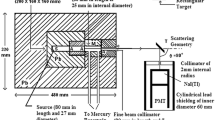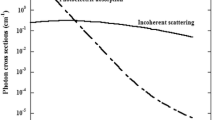Abstract
Linear attenuation coefficient, mass attenuation coefficient, differential scattering cross sections, effective atomic number (Zeff), effective electron density are the parameters used to determine interaction of X-/gamma rays with any material. These parameters depend on photon energy and chemical composition of the studied material. The scattering process is a convenient method for material characterization as it contains less doses than transmission. In the present study, a theoretical estimation based on the scattering of radiation was used to calculate total molecular mass differential scattering coefficients (TMMDSC) of different types of materials for 137Cs and 60Co radioisotopes covering Compton energy region and for varying scattering angles. For this aim, differential Compton and Rayleigh scattering cross sections (based on Klein-Nishina and Thomson formula) were used for different momentum transfer values. Using the data obtained, practical fit equations were determined to calculate Klein-Nishina and Thomson cross sections for studied momentum transfer range. Using these equations TMMDSC of any material can be easily estimated. Furthermore, Zeffs of the selected materials were studied in the same momentum transfer range based on Rayleigh to Compton scattering ratio for the first time. Values of Zeff, which is one of the most important parameter to distinguish or identify multi-element materials, was compared to those of mean atomic numbers and it was found that the relative differences can reach up to 76.54%.






Similar content being viewed by others
Data Availability Statement
This manuscript has associated data in a data repository. [Authors’ comment: All data generated or analysed during this study are included in this published article.]
References
D.N. Hopkins, M. Maqbool, M.S. Islam, Linear attenuation coefficient and buildup factor of MCP-96 alloy for dose accuracy, beam collimation, and radiation protection. Radiol. Phys. Technol. (2012). https://doi.org/10.1007/s12194-012-0158-1
F.H. Attix, An introduction to radiological physics & radiation dosimetry (Wiley, New York, 2008)
S.R. Manohara, S.M. Hanagodimath, L. Gerward, Energy absorption buildup factors for thermoluminescent dosimetric materials and their tissue equivalence. Rad. Phys. Chem. (2010). https://doi.org/10.1016/j.radphyschem.2010.01.002
L. Gerward, N. Guilbert, K. Jensen, H. Levring, X-ray absorption in matter. Reeng. XCOM. Rad. Phys. Chem. (2001). https://doi.org/10.1016/S0969-806X(00)00324-8
J.E. Turner, Atoms, Radiation, and Radiation Protection, 3rd edn. (Wiley-VCH Verlag GmbH & Co. KGaA, Germany, 2012)
J.E. Martin, Physics for Radiation Protection, 3rd edn. (Wiley-VCH Verlag GmbH & Co. KGaA, Germany, 2013)
M.J. Cooper, A.J. Rollasonf, R.W. Tuxworth, Gamma-ray scattering studies of composition variations in alloys. J. Phys. E: Sci. Instrum. (1982). https://doi.org/10.1088/0022-3735/15/5/022
P. Duvauchelle, G. Peix, Effective atomic number in the Rayleigh to Compton scattering ratio. Nucl. Instrum. Methods Phys. Res., Sect. B (1999). https://doi.org/10.1016/S0168-583X(99)00450-4
M.S. Gobo, L.D. Soares, M.E. Poletti, Effective atomic number of breast tissues determined by transmission and scattering methods. Rad. Phys. Chem. (2019). https://doi.org/10.1016/j.radphyschem.2019.04.010
L.S. Lama, L.D. Soares, M. Antoniassi, M.E. Poletti, M. E. Effective atomic numbers for materials of medical interest at low photon energy using the Rayleigh to Compton scattering ratio. Nuclear Instrum. Methods Phys. Res. Sect. A Acceler. Spectromet. Detect. Assoc. Equip. (2014). https://doi.org/10.1016/j.nima.2014.12.046.
M. Antoniassi, A.L. Conceição, M.E. Poletti, Study of effective atomic number of breast tissues determined using the elastic to inelastic scattering ratio. Nuclear Instrum. Methods Phys. Res. Sect. A Acceler. Spectromet. Detect. Assoc. Equip. (2010). https://doi.org/10.1016/j.nima.2010.09.110.
E.A. Ryan, M.J. Farquharson, The differentiation between malignant and non-malignant breast tissues using elastic and inelastic scattering of synchrotron radiation. . Nuclear Instrum. Methods Phys. Res. Sect. A Acceler. Spectromet. Detect. Assoc. Equip. (2009). https://doi.org/10.1016/j.nima.2009.12.020
M. Kurudirek, M. Büyükyıldız, Estimation of effective atomic number in the Rayleigh to Compton scattering ratio using different methods. Nuclear Instrum. Methods Phys. Res. Sect. A Acceler. Spectromet. Detect. Assoc. Equip. (2016). https://doi.org/10.1016/j.nima.2016.03.029.
T.T. Thanh, L.H. Minh, N.Q. Cuong, H.D. Chuong, N.D. Thong, V.D. Nguyen, C.V. Tao, Study of different methods to estimate the Rayleigh to Compton scattering ratio and the effective atomic number (10 < Z < 30) using Si(Li) detector. Nuclear Instrum. Methods Phys. Res. Sect. A Acceler. Spectromet. Detect. Assoc. Equip. (2020). https://doi.org/10.1016/j.nima.2020.163995.
E. Cinan, D. Yılmaz, Effective atomic numbers of boron compounds obtained using Rayleigh to compton scattering intensity ratio. Appl. Radiat. Isot. (2021). https://doi.org/10.1016/j.apradiso.2021.109753
D. Demir, A. Turşucu, Measurement of the effective atomic number of FexCr1−x and FexNix alloys using scattering of gamma rays. J. Alloy. Compd. (2013). https://doi.org/10.1016/j.jallcom.2013.07.057
P. Limkitjaroenporn, J. Kaewkhao, W. Chewpraditkul, P. Limsuwan, Mass attenuation coefficient and effective atomic number of Ag/Cu/Zn alloy at different photon energy by compton scattering technique. Procedia Eng. (2012). https://doi.org/10.1016/j.proeng.2012.02.022
M. Buyukyildiz, M. Kurudirek, A study of the effective atomic number of SixPb0.7-x(Fe2O3)0.3 ternary alloys for photons. Nuclear Technol. Radiat. Protect.. (2016). https://doi.org/10.2298/NTRP1604327B.
M. Büyükyıldız, Determination of the effective atomic numbers of Fex Cu1−x binary ferroalloys using a nondestructive technique: Rayleigh-to-Compton scattering ratio. Turk. J. Phys. (2016). https://doi.org/10.3906/fiz-1603-25
E. Yorke, D. Gelblum, E. Ford, Patient safety in external beam radiation therapy. Am. J. Roentgenol. (2011). https://doi.org/10.2214/AJR.10.6006
R.W. Alexander, K.T. Thiele, M. Maqbool, Electronic cross-sections and Compton attenuation and transfer coefficients of 82Pb208, 29Cu64, 27Co59, 20Ca40 and 13Al27 for applications in radiation shielding and dose. Phys. Scr. (2020). https://doi.org/10.1088/1402-4896/ab9e23
O. Holmberg, R. Czarwinski, F. Mettler, The importance and unique aspects of radiation protection in medicine. Eur. J. Radiol. (2010). https://doi.org/10.1016/j.ejrad.2010.06.031
M. Alenezi, K. Stinson, M. Maqbool, N. Bolus, Klein-Nishina electronic cross-section, Compton cross sections, and buildup factor of wax for radiation shielding and protection. J. Radiol. Prot. (2018). https://doi.org/10.1088/1361-6498/aaa57b
A. Tartari, Molecular differential cross sections for low angle photon scattering in tissues. Rad. PhyS. Chem. (1999).https://doi.org/10.1016/S0969-806X(99)00281-9.
O. İçelli, An experimental study on linear differential scattering coefficients of the radioactive compounds UO2(C2H3O2)2 · 2H2O and Th(NO3)4 · 5H2O at 60 keV. Ann. Nucl. Energy (2004). https://doi.org/10.1016/j.anucene.2004.07.002
O. İçelli, Practical method for experimental effective atomic number in the coherent to Compton scattering ratio. J. Quant. Spectrosc. Radiat. Transf. (2005). https://doi.org/10.1016/j.jqsrt.2005.11.014
O. İçelli, G. Çankaya, A. Çetin, An experimental study on the linear differential scattering coefficients of the GaAs, n- and p-type Si. Nuclear instruments and methods in physics research section a: accelerators, spectrometers, detectors and associated equipment. (2009). https://doi.org/10.1016/j.nima.2009.04.005.
O. İçelli, Measurements of the total molecular differential attenuation coefficients of some compounds for scattering of γ-rays. Ann. Nucl. Energy (2008). https://doi.org/10.1016/j.anucene.2008.08.002
O. Klein, T. Nishina, Über die Streuung von Strahlung durch freie Elektronen nach der neuen relativistischen Quantendynamik von Dirac. Z. Phys. (1929). https://doi.org/10.1007/BF01366453
J.H. Hubbell, W.J. Veigele, E.A. Briggs, R.T. Brown, D.T. Cromer, R.J. Howerton, Atomic form factors, incoherent scattering functions, and photon scattering cross sections. J. Phys. Chem. Ref. Data (1975). https://doi.org/10.1063/1.555523
G.J. Hine, The effective atomic number of materials for various gamma ray process. Phys Rev. (1952).
ICRU Report 44, International Commission on Radiation Units and Measurements. Tissue Substitutes in Radiation Dosimetry and Measurement, (1989). ICRU, Report 44.
Author information
Authors and Affiliations
Corresponding author
Rights and permissions
About this article
Cite this article
Büyükyıldız, M., Tuna, G. & Kurudirek, M. The differential scattering parameters of different types of materials in Compton energy region for nuclear applications. Eur. Phys. J. Plus 137, 761 (2022). https://doi.org/10.1140/epjp/s13360-022-02977-0
Received:
Accepted:
Published:
DOI: https://doi.org/10.1140/epjp/s13360-022-02977-0




